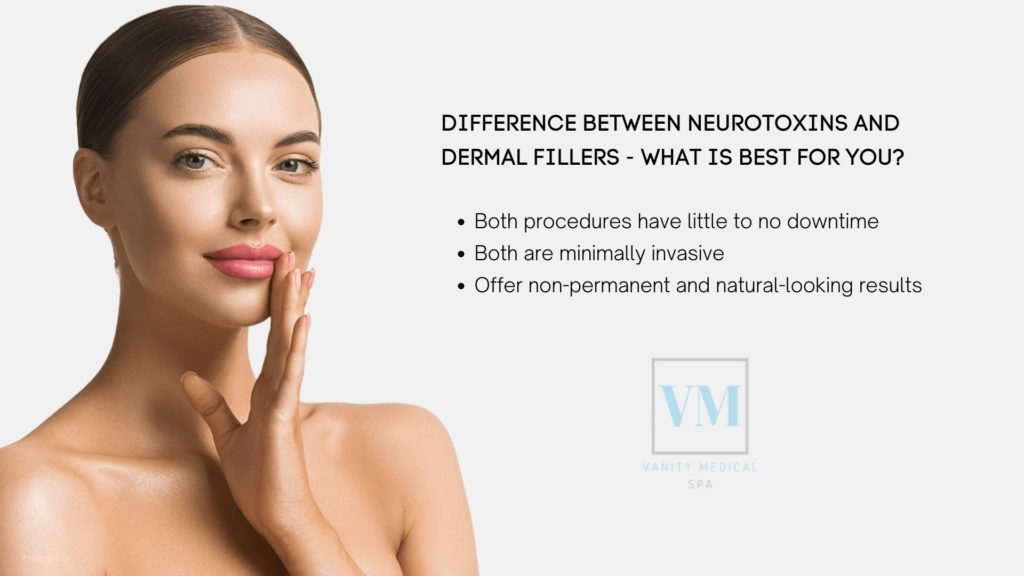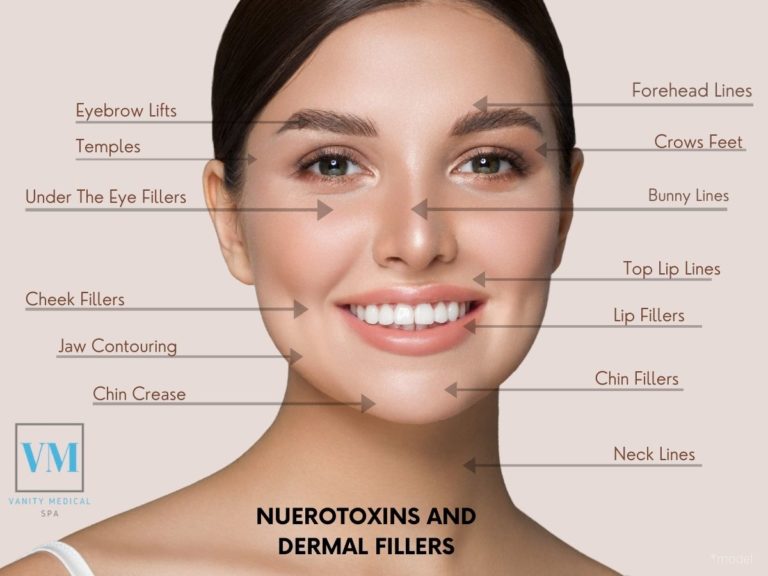Options for injectable treatments are widely abundant. If you are considering having an injectable treatment to reduce wrinkles but can’t figure out the difference between neurotoxins and dermal fillers, you are at the right place. With different injectable treatments available in the market for different purposes, knowing which one is best can be quite confusing.
At Vanity Medical Spa, we are all for providing you with the right information and clearing your confusion about different cosmetic procedures.
There are two giant beasts in the cosmetic world when it comes to injectable anti-aging treatments: Neurotoxins and dermal fillers. People often confuse these two, but they are very different!
In this article, we will discover the key differences between dermal fillers and neurotoxins and discuss which one is the right option.
What makes dermal fillers and neurotoxins similar?
Before discussing the differences, let’s look at some of the similarities between dermal fillers and neurotoxins.
- Both procedures have little to no downtime
- Both are minimally invasive
- Offer non-permanent and natural-looking results
So, these are the only few characteristics both treatments have in common. To know more about the treatments, read below.
What are dermal fillers?
Dermal filler is an anti-aging treatment that injects different substances beneath the layers of skin to add fullness and volume.
Substances that are commonly used in dermal filler treatments include:
- Polylactic acid, a collagen booster.
- Polyalkylimide, a transparent gel that is highly compatible with the skin.
- Hyaluronic acid, a fluid that is present in the body tissues and adds plumpness to the skin texture.
- Calcium hydroxyapatite, a mineral-like substance present in bones.
- Polymethyl-methacrylate microspheres (PMMA), a dermal filler agent that is semi-permanent.
All these agents or substances are used to treat different cosmetic issues and wrinkles at different stages. These fillers are not permanent, and their lives also vary. Some of these substances last 6-7 months, while others remain effective for up to 2 years.
It is best that you consult with a dermatologist who is an expert in cosmetic procedures before taking the dermal filler treatment. Your doctor will examine your skin and suggest you the best treatment that suits your current skin condition.
Dermal fillers can help you treat different signs of skin aging. Depending on the type of filler treatment, it may:
- Plump up shallow areas in your skin and lips.
- Reduce the appearance of shadows and under-eye wrinkles.
- Reduce static wrinkles.
- Soften the appearance of recessed scars.
Dermal fillers are an FDA-approved treatment, but there can be some side effects. Be sure to consult a dermatologist that uses only FDA-approved fillers and syringes.

What are Neurotoxins?
Neurotoxins are also injectables used to treat wrinkles and other signs of anti-aging. However, this treatment is administered via an agent called Botulinum Toxin Type A.
According to the American Board of Cosmetic Surgery, these injectables are widely used in America and are considered one of the most popular cosmetic injections.
Neurotoxin injections are used to treat wrinkles that are results of pouting, squinting, smiling, or other facial expressions. The mechanism of this treatment is quite simple. When neurotoxins are injected into the skin, they block nerve impulses to your face muscles, which causes relaxation and softening. This mechanism causes the muscles around your face to soften and loosen up, drastically reducing the fine lines and wrinkles. It is important to note that patients do not immediately observe the results of neurotoxin injections. Complete results are often observed after one or two weeks of the treatment.
Common neurotoxin treatments approved by the FDA include:
These treatments are commonly used to reduce wrinkles, but they can also be good for TMJ, excessive sweating, and vertical neckbands.

Difference Between Neurotoxins and Dermal Fillers
Both neurotoxins and dermal fillers are injectable treatments used to treat visible signs of aging but in different ways. We are listing down some key differences between the two treatments.
- The amount of time it takes for the treatment to take effect is different for both procedures. With neurotoxins injections, patients usually observe differences within or after 2 weeks of the treatment. On the other hand, patients who have taken dermal filler treatments observe differences immediately. However, it is common for patients to observe some swelling or redness after the dermal filler procedure.
- Neurotoxin injectables are a viable option for people who are looking to treat dynamic wrinkles. Neurotoxins are good to reduce the movement of facial muscles, which causes wrinkles to appear. Wrinkles appearing around the forehead, between the eyebrows, or around the crow’s feet are usually treated with neurotoxin injections, which gives better results as compared to dermal fillers.
- Dermal filler is the best treatment for reducing static wrinkles. These types of wrinkles are permanent and stay on your face even when there is no facial expression. Static wrinkles are normally treated with dermal fillers, which softens the skin muscles and enhances the overall skin texture.
Dermal fillers or Neurotoxins—what is the best option?
Both treatments use injectables and treat visible signs of aging. However, dermal fillers are the best option for treating static wrinkles, that normally appear on the lower side of your face. these wrinkles are the permanent resident on your face and don’t go away even when your face is empty of expression. Dermal fillers bring fullness and volume to these wrinkle-stricken areas and reduce the appearance of age lines
Neurotoxins, on the other hand, are good for reducing dynamic wrinkles. These wrinkles appear when you smile, pout, or squint. Neurotoxins can block the nerve impulses to these areas and soften the skin so that wrinkles appear less visible.
Both treatments are approved by the FDA and significantly reduce signs of aging. It is best that you consult with a professional dermatologist before taking any cosmetic treatment for wrinkles
At Vanity Medical Spa, we have experts who overlook all our cosmetic procedures. From Botox to dermal fillers, we administer all cosmetic procedures for wrinkles with precision and care. Contact us today to schedule an appointment and explore all options available (201) 815-5950
Schedule An Appointment


